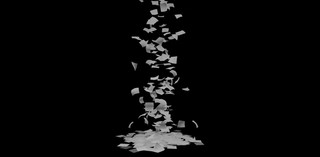Animation Shorts: Lightness in Gravity Ages 15+

Production still from these are the days 1994-2012 / Director: John Tonkin / Image courtesy: John Tonkin / View full image
When
10.30 am, Sun 20 Feb 2022 (52 mins)About
A selection of works by video artists who employ animation techniques to capture and distill time and motion to its purist form. These mesmerising works move effortless from hypnotic renderings of video game scenes, synchronisation of light, texture and sound, to the gentle decent of falling paper. Features early animations by Ian Haig, Arlo Mountford, Paul Fletcher, Daniel Crooks and John Tonkin alongside more recent works.
This strand contains flashing images.
K-Rad Man 1992 dir. Ian Haig (11 mins)
“A mad scientist develops a computer virus designed to manifest itself as a biological life-form which wreaks havoc with an unsuspecting computer nerd.” The National Film and Sound Archive, Canberra
Another Brutally Satisfying Video 2014 dir. Ian Haig (2 mins)
“Visceral death scenes and fatalities from Mortal Kombat are overlayed with one another.
Another Brutally Satisfying Video renders the human body as a mass of flesh, bone, gristle, muscle and blood; it is the human body in an un-recognizable, hyper accelerated state. Over pumped, over saturated and over blown - the body taken to its extreme, multiplied and extended. The advances in computer game technologies coincides here with an ever increasingly appetite for the rendering of visceral death scenes and the destruction and breakdown of the human body.” Ian Haig
Stand up 2007 dir. Arlo Mountford (3.15 mins)
“Stand Up 2007 approached the more tragic side of stand up comedy, the simple head proposing a manifesto for art making to its canned laughter audience.” Arlo Mountford
Galaxy Express NMWA 2014 dir. Arlo Mountford (6.18 mins)
“The result of trips to Japan, Galaxy Express NMWA used the anomalous National Museum of Western Art in Tokyo as the site for the restaging of the climax to Leiji Matsumoto’s 1978 anime, Galaxy Express 999. This particular scene was animated by Yoshinori Kanada and is known for its expressive explosions and extreme camera angles.
Thrown into the mix are works by the Japanese avant-garde or Gutai movement from the 1950s and 60s. These combined with the building itself which was designed by Le Corbusier in 1955 and the strange oedipal notions of progress represented Galaxy Express 999 resulted in a mashup of misguided modernist symbols and beliefs.” Arlo Mountford
The Drive to Work 2017 dir. Paul Fletcher (3.23 mins)
“Taking its title from the road facing site of the installation version a reference both to the compulsion or drive to work, do 'something', make art, make short films and so on as well as more literally meandering thoughts on the drive to work, semi hypnotised by the white lines in the middle of the road.” Paul Fletcher
Alien Brain Therapy 2020 dir. Paul Fletcher (3.49 mins)
“A synchronicity of simultaneous shaping and progression of sharp synthetic sounds and animation of elemental shapes colours and textures. Generative, improvised, and carefully edited abstract narrative progression as memorable as it is forgettable… an ambient and experiential journey.” Paul Fletcher
food(for)thought; (three) ingredients from the mass consumer diet 1994 dir. Daniel Crooks (7.25 mins)
“Take a clean bowl. Add some loaves of bread, a few religious icons and a healthy dollop of television. Beat vigorously and bake on high for several minutes. Serve hot.” Screen Australia
Static No.23 (Revolve) 2017 dir. Daniel Crooks (5.45 mins)
“Static No. 23 (Revolve) is a digitally manipulated video by New Zealand–born Australian artist Daniel Crooks. Filmed with a fixed camera in the middle of bustling Wan Chai Road in Hong Kong, the 2017 work captures and distorts the rhythms of the city. Bodies and buildings expand and contract, while forms and colours morph into and away from each other. The effect is reminiscent of a Cubist painting, where subjects are geometrically fragmented and portrayed from multiple angles. In making Static No. 23 (Revolve), Crooks sought to capture the remaining vestiges of traditional Hong Kong street life in a cityscape increasingly saturated by global franchises.
Crooks’s videos shift our perception of space and time by harnessing the power of digital production and editing. The artist treats time as a physical, malleable material, while always retaining the integrity of his core imagery, tethering it to a world that people know and experience every day.” M+, Hong Kong
air, water (part 3) 1993 dir. John Tonkin (3.20 mins)
air, water is a series of lyrical and poetic animated studies of the elements air and water. The artist has written software to create simulations of natural phenomena using mathematical models of physical forces such as gravity, aerodynamics and elasticity. Although these simulations are relatively abstracted, the motion they exhibit is both complex and naturalistic. These virtual environments evoke a range of emotional tones. In contrast to much computer animation which seems to aspire to ever more dense and spectacular imagery, these works are visually sparse and deliberately simple. The sound-tracks, composed by Tony Kastanos, are played by an acoustic ensemble. air,water was produced in association with the Australian Film Commission.
these are the days 1994-2012 dir. John Tonkin (3.12 mins)
'By combining mathematical models of different physical phenomena such as gravity, elasticity and aerodynamics I can create abstracted simulations of natural systems. As well as the formal qualities that are explored in this work, I am interested in other possible readings. The endless flow of paper suggests the meditative space of a waterfall, yet also speaks of consumption and waste. Our lives are documented by a continual stream of paper, from birth and death certificates to supermarket receipts. these are the days was produced in association with the Australian Film Commission.' John Tonkin
Bugbug Temple 2014 dir. John Power (4.10 mins)
"A nocturnal ascent." John Power
Ages 15+
Production Credits
- Directors: Ian Hai, Arlo Mountfor, Paul Fletche, Daniel Crook, John Tonki, John Power
- Runtime: 52 minutes
- Screening Format: Digital

